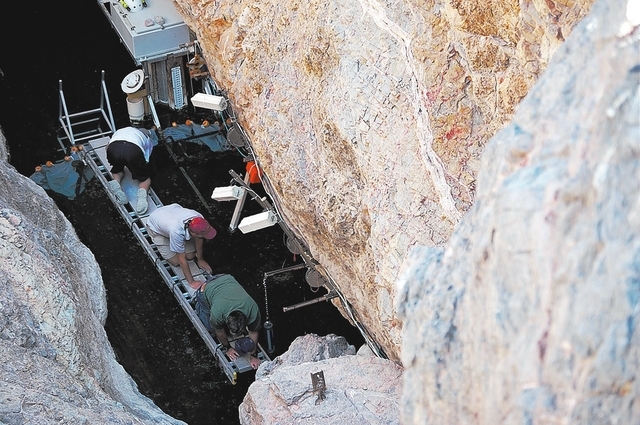
AMARGOSA VALLEY – The fall 2013 count for the Devil’s Hole pupfish, conducted Sept. 28 and 29, was 65.
This is lower than the fall 2012 count of 75 — which at the time was the lowest number counted in the fall — but the presence of a range of size classes indicates that the fish continue to reproduce, the U.S. Fish and Wildlife Service reported. The population is officially counted twice per year in the spring and fall, and fall numbers are naturally higher than spring numbers. Last spring the census counted only 35 Devil’s Hole pupfish.
“This fall count represents an extension of the overall decline of the Devil’s Hole pupfish since the mid-1990s,” said Ted Koch, Nevada State Supervisor for the U.S. Fish and Wildlife Service. “While we did see an increase in the population over the summer months, which is positive, there is historically a 35 to 65 percent die-off of the population over the winter months that could keep the population critically low. We need to continue working to understand what are likely to be the most significant causes for the decline and take action to address them.”
Recent actions taken by the cooperating agencies since the low spring count, include adding natural and artificial plant material to the habitat to augment cover for pupfish and provide additional surface area for the development of algae, which provides a food source. Additionally, the agencies began experimental attempts to collect pupfish eggs from Devil’s Hole to determine the viability of establishing a population at the Ash Meadows Fish Conservation Facility. Scientists also modified the supplemental feeding program to increase the quality of feed for the pupfish. Supplemental feeding was initiated experimentally in 2007, when pupfish numbers initially declined to near the levels observed currently, to address observed changes in Devil’s Hole food resources that may have been impacting the species’ survival.
The number of fish counted during each survey is considered to be an index of the number of observable pupfish, based on a methodology that has been in use for 41 years. The Devil’s Hole pupfish has a lifespan of approximately one year in the wild. It has been under federal protection since 1967.
Managers and biologists from the U.S. Fish and Wildlife Service, the National Park Service, and the Nevada Department of Wildlife are evaluating methods to help conserve the species through continuing studies of the physical, chemical, and biological factors that influence pupfish survival and reproduction. Additional management actions will be based on the results of these investigations.
The Devil’s Hole pupfish is one of the world’s rarest fishes, spending most of its life in the top 80 feet of the 93-degree waters of Devil’s Hole — a cavern in the Mojave Desert managed by the National Park Service as part of Death Valley National Park. The U.S. Fish and Wildlife Service and Nevada Department of Wildlife also help manage the fish and its habitat, which is one of the smallest natural ranges known for any vertebrate (fish, amphibian, reptile, bird or mammal). Devil’s Hole has always been an extreme environment, with water temperatures and dissolved oxygen concentrations near the upper physiological limits for fish. Devil’s Hole pupfish are thought to have survived and adapted to these harsh conditions for thousands of years.
With so few individuals in just one small and challenging location, it is difficult to conduct large-scale experiments to determine specific causes for the population decline. However, management agencies and partners continue to work to conserve the species while minimizing disturbance of the fish and its habitat.
Earlier this year, a hybridized form of Devil’s Hole pupfish was moved to the Ash Meadows Fish Conservation Facility. The state-of-the-art facility was constructed to mimic the natural conditions of Devil’s Hole. The fish were moved to aquaria where biologists can conduct important research without disrupting the wild fish in Devil’s Hole.